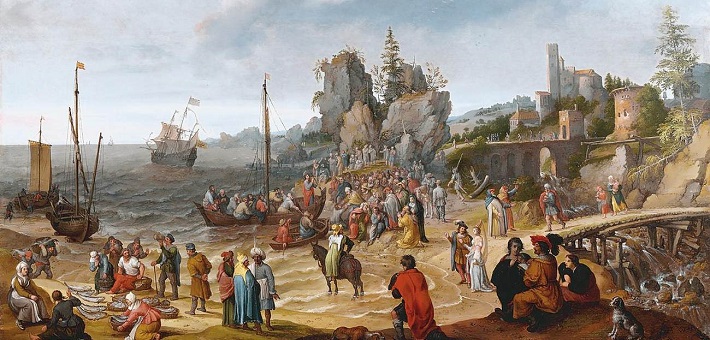Commentary on 2 Samuel 7:1-14a
David’s lack of tolerance for frustration over the constraints of his limits stands in the way of God’s future unfolding. Nathan frames this as David’s spiritual task to learn humbleness.1 David will lay the groundwork for a dynastic house of rulers, yet he will not build the house of stone that will host the ark. This task will instead be reserved for his successor. For his own days, David must accept the transitory tent as provisional housing of the ark and as a reminder of his limited power.
This is a call to forbearance in the season of Pentecost. David finds himself in the tension of an “already now” and a “not yet.” At this time in the liturgical year, we primarily celebrate the fulfillment of the constitution of the church. As Christians, we exist in a tension between an already/not yet. David’s spiritual growth is measured against his acceptance of an interim solution: a preliminary dwelling space in a yet-to-be-fully-established national home. Inhabiting and claiming one’s time in a productive dynamic between the “already now” and the “not yet” of a longer project is an art and accomplishment of faith.
The king would prefer the long-term solution of a temple of stone with the welcome side effect of an image boost. Yet, determining this venture is not up to him. Rather, the prophet corrects David’s expectations, pointing to his twofold success: his name will be remembered, and he already now sees God’s people settling securely, undisturbed from its enemies, “so that they may dwell in their own place and be disturbed no more” (verse 10). The prophet Nathan invites us together with David to balance our aspirations and our limits in light of God’s great promises and God’s plan for a long story arc.
Already now David’s leadership can claim success and he will be the namesake of the dynasty that brought the ark to Jerusalem. David is a catalytic figure who has a transitional role of conquering the city, so the people arrive there and claim the future capital. This passage strikes a careful balance, though, between God providing King David a sense of security and offering a provisional shelter for the ark in a tent for now, as well as the hope of a more permanent home in a house in the time to come.
With the conquest of Jerusalem, 2 Samuel 7 reflects on an essential aspect of the settlement narrative. The house of stone may evoke contemporary struggles of the upkeep of the “houses of stone” of congregations, crumbling with the need for maintenance deferred while mourning the days when they needed to set up chairs in the narthex for Easter. The reflection on the establishment of the temple can be juxtaposed with congregational experiences of volatility and the use of temporary space, while turning old sanctuaries into arts centers, trapeze schools, or residential housing. David, like most faith leaders, wants stability, yet needs to accept God’s dwelling in the tent.
Might our assemblies have always been meant to be more provisional than the stones and roofs may have led us to believe? The preacher may recapture traditions of the pilgrimage church, such as the Priestly writer’s itinerant sanctuary in which God is “tenting” with us in Exodus 25–31, and may choose to poignantly draw out the emotional and spiritual balance of the dialectic between the settled and the itinerant nature of faith communities.
Decolonizing the tradition
The prophet Nathan addresses typical aspirations of David’s royal hubris. But Nathan also challenges us as a people of faith to think of ourselves analogously as pilgrims underway and as Christians to align this message with the coordinate system of a largely sedentary settlement culture in a Western empire. What might be constructive paths to decolonize our heritage as the Christian church in America? How might we adopt Nathan’s reminder to David as the ruler of the small Judean state whom God had raised from being a little shepherd boy to become a leader?
Like David, the church is neither static nor stagnant, but it consistently finds itself underway. Martin Luther conceives of our faith life as a dynamic trajectory of pilgrims on the move: “This life therefore is not righteousness, but growth in righteousness. … We are not yet what we shall be, but we are growing toward it; the process is not yet finished, but it is going on; this is not the end, but it is the road.”2
Second Samuel 7 can be read as an invitation to affirm and claim the dynamic of our future and to understand ourselves as faithful pilgrims.
“I took you from the pasture. … I have been with you” (verses 8–9)
God’s choice of David is based in non-obligatory, free affirmation. This is both a bold reminder of leadership as a non-obligatory gift and a forthright warning that David might not take his leadership for granted. David recognizes that his capability as a leader is grounded in God’s selection. This makes him a humble servant in his responsible position. How might preachers talk to values such as responsibility and servanthood as the hallmarks of public service (see also Jeremiah 23:1–6) in our time?
It may or may not be necessary that one embed their faith journey in the concept of servanthood. Yet, key features of leadership, such as charisma and honesty, are critical. God calls his leaders to be shepherds. This image conceives of David the ruler as guide over the community.
“When your days are fulfilled, and you lie down with your fathers” (verse 12)
The peaceful burial and eternal resting place for David are a token of his dynasty’s meaning for posterity. This reference to David’s honor in the days to come may direct the preacher to the legacy of congregational life: “As we will fulfill our days, how might we as a congregational collective have built up a ‘house of living stones’ in a neighborhood strengthened into the future?”
Notes
- The author thanks the Rev. Dr. Kim Beckmann for commenting on earlier versions of this commentary.
- The German original is in “Grund und Ursach aller Artikel, 1521,” in: D. Martin Luthers Werke 7 (Weimar: 1883–2009), 336.


July 21, 2024